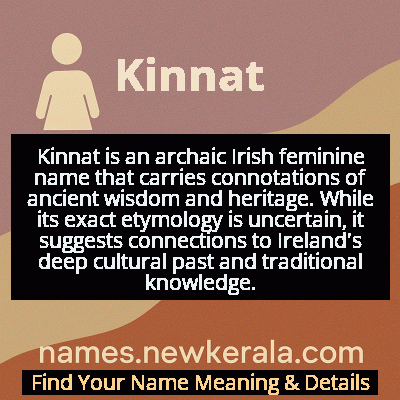Kinnat Name Meaning & Details
Origin, Popularity, Numerology Analysis & Name Meaning of Kinnat
Discover the origin, meaning, and cultural significance of the name KINNAT. Delve into its historical roots and explore the lasting impact it has had on communities and traditions.
Name
Kinnat
Gender
Female
Origin
Irish
Lucky Number
6
Meaning of the Name - Kinnat
Kinnat is an archaic Irish feminine name that carries connotations of ancient wisdom and heritage. While its exact etymology is uncertain, it suggests connections to Ireland's deep cultural past and traditional knowledge.
Kinnat - Complete Numerology Analysis
Your Numerology Number
Based on Pythagorean Numerology System
Ruling Planet
Venus
Positive Nature
Harmonious, responsible, caring, and artistic.
Negative Traits
Overly idealistic, superficial, possessive, or jealous.
Lucky Colours
Pink, turquoise.
Lucky Days
Friday.
Lucky Stones
Diamond, turquoise.
Harmony Numbers
2, 3, 9.
Best Suited Professions
Artists, musicians, teachers, healthcare workers.
What People Like About You
Warmth, nurturing nature, artistic flair.
Famous People Named Kinnat
Kinnat O'Malley
Poet and Bard
Preserved ancient Irish oral traditions through poetic works during the Tudor conquest
Kinnat MacCarthy
Clan Historian
Documented the genealogy and legends of the MacCarthy clan in Munster
Kinnat Fitzgerald
Abbess and Scholar
Founded a scriptorium that preserved early Christian manuscripts in Connacht
Name Variations & International Equivalents
Click on blue names to explore their detailed meanings. Gray names with will be available soon.
Cultural & Historical Significance
During the Gaelic Revival of the 19th and early 20th centuries, names like Kinnat experienced brief resurgences as Irish intellectuals sought to reconnect with their cultural heritage before English dominance. However, unlike many revived names, Kinnat remained largely in the domain of scholars and historians, never achieving widespread popular usage. Its preservation primarily occurred through genealogical records, ancient manuscripts, and the work of antiquarians who documented Ireland's linguistic heritage.
The name's cultural significance lies in its representation of Ireland's complex relationship with its pre-colonial identity. As an essentially extinct given name, Kinnat serves as a reminder of the thousands of names lost during centuries of cultural suppression and linguistic shift. It stands as a testament to the diversity of Ireland's naming traditions before standardization and Anglicization dramatically reduced the variety of names in common usage.
Extended Personality Analysis
Those bearing the name Kinnat are often perceived as possessing a deep connection to tradition and history, carrying themselves with a quiet dignity that suggests ancient wisdom. They tend to be reflective individuals who value knowledge and cultural preservation, often displaying remarkable memory for stories, genealogies, and historical details. Their strength lies in their ability to bridge past and present, making them natural historians, teachers, or custodians of family and community traditions.
Kinnats typically exhibit a strong sense of loyalty to their roots and demonstrate patience in their pursuits, understanding that some truths unfold gradually over time. They may appear reserved initially but reveal profound insight and warmth to those who earn their trust. Their personality often combines the steadfastness of ancient stones with the adaptability of flowing water - grounded yet capable of navigating changing circumstances with grace and intelligence.
In interpersonal relationships, Kinnats are often the keepers of family lore and community memory. They possess an innate understanding of cycles and patterns, allowing them to provide perspective during challenging times. While not typically seeking the spotlight, they wield quiet influence through their wisdom and reliability. Their combination of historical awareness and practical insight makes them valuable counselors and trusted advisors in both personal and professional contexts.
Modern Usage & Popularity
In contemporary times, Kinnat remains exceptionally rare, primarily appearing among families with strong connections to Irish heritage preservation or those seeking uniquely archaic names. Its usage is largely confined to academic circles, historical reenactment communities, and families dedicated to reviving nearly-extinct Gaelic names. The name has not appeared in official birth registries in significant numbers for over a century, making it one of Ireland's truly endangered names. Modern parents who choose Kinnat typically do so as a conscious cultural statement rather than following naming trends, often pairing it with more familiar middle names to balance its archaic quality with contemporary practicality.
Symbolic & Spiritual Meanings
Symbolically, Kinnat represents the persistence of cultural memory and the importance of preserving ancient wisdom. It embodies the concept of the 'crannóg' - the artificial islands built in lakes that served as places of refuge and preservation in ancient Ireland. Like these structures, the name suggests protection of valuable knowledge against the tides of time and cultural change. It also carries connotations of the 'seanchaí' or traditional storyteller, symbolizing the vital role of oral history and the transmission of cultural identity across generations. The name evokes images of ancient standing stones that silently witness centuries of change while maintaining their essential character, representing endurance and the quiet power of cultural continuity.

